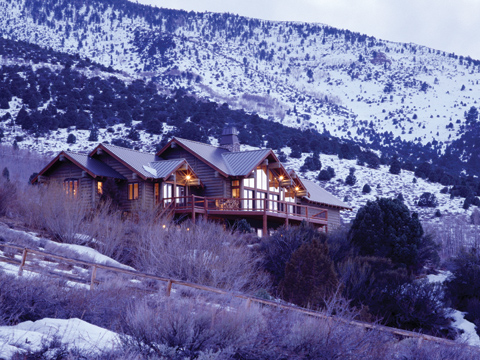Maintaining your log home is like getting on a physical fitness regimen: to keep it performing and looking its best, you have to take care of it. And like embarking on a nutrition and exercise program for your body, your log home maintenance has to stick to a regular schedule, or the health of your home will suffer, and you’ll have to have to start over from square one—which could be much more difficult than sticking to the plan in the first place.
If you’re like most log home enthusiasts, you’re in this for the long term and as the old adage goes, an ounce of prevention is worth a pound of cure. So what can you do to make long-term maintenance easier?
The number one secret to maintaining your log home with ease starts in the most surprising place—the design phase—and proper siting is the key.
Now, if your log home will be located in the Louisiana bayou, your siting needs will be different than someone who’s home will be perched in the peaks of the Rockies, but as a general rule, use your land to your advantage. Though it’s tempting to site your home on the highest point of your land, resist the urge. Instead, study the prevailing wind patterns and site the home below the ridge on the leeward side. Your land will provide natural shelter from harsh winds and keep your log walls from taking unnecessary abuse.
For a low-maintenance-design imperative, just look up. Proper roof design can extend the life of your logs. Excessive moisture and UV rays are a log wall’s enemy and by designing your home to combat them for you will make your ongoing maintenance much easier. Again, climate conditions play a huge role, but no matter if you’re protecting your walls from sun or snow, designing eaves that are at least two to four feet deep (you may want to go as deep as eight feet in some regions) will help keep the elements from direct contact with your exterior logs. An added bonus? You’ll have a charming porch to extend your living area outdoors.
Another roof design tip has to do with the materials you choose. A genuine cedar shake or shingle roof may be tough to maintain in areas with extreme weather or snow loads that will sit on the roof throughout the winter. A metal roof might be a better bet, since it sheds the white stuff easily. Plus, a quality metal roof won’t rust or fade. Metal roofs, as well as clay tiles, also can be smart choices in areas prone to wildfire, since they won’t ignite.
For many buyers, a log home isn’t complete without a wall of windows to usher nature’s beauty inside. If this is a feature you desire for your home, use it to your maintenance advantage. Position the window wall on the south side of the house. In the Northern Hemisphere, the south-facing wall of a home gets the brunt of the sun’s force, and remember: UV rays are not log friendly. So by reducing the number of logs you have on the southernmost wall, you’ll minimize your upkeep. Plus, this passive-solar tactic (combined with proper glazing) can help reduce your energy consumption and save you money.
The windows you choose can help you reduce your interior log home maintenance, too. Choose windows with a UV filter that diffuses the sun’s harsh rays and helps keep the logs inside from fading, thus reducing the need for interior stain reapplication.
When it comes to using design to reducing log home maintenance over the long haul, there’s a key component many people overlook: their landscape design.
How much can a shrub or tree affect your maintenance regimen you ask? Plenty. Bushes placed too close to your log walls can trap moisture against them, increasing the potential for mold, rot, and insect infestation. Keeping greenery and mulch at least three feet from your logs will keep damage at bay.
Proper sloping of your property is essential for proper runoff, ushering water down and away from your home. So what is a proper slope? The general consensus is about six inches for the first 10 feet from your foundation. But how do you determine what your slope is to begin with? eHow.com offers an easy to understand slope calculator to help you determine if you need to make corrections.
Some simple design strategies at the onset can help you enjoy your log home, rather than simply maintaining it. Plan it right from the beginning and it will treat you right.
Photography by Roger Wade Studio


